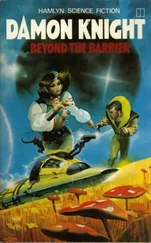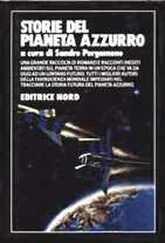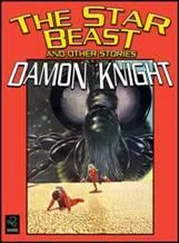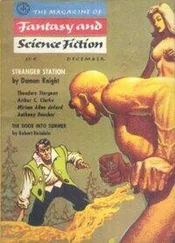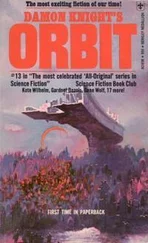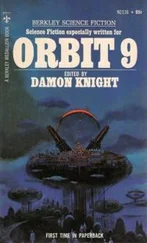Damon Knight - Orbit 21
Здесь есть возможность читать онлайн «Damon Knight - Orbit 21» весь текст электронной книги совершенно бесплатно (целиком полную версию без сокращений). В некоторых случаях можно слушать аудио, скачать через торрент в формате fb2 и присутствует краткое содержание. Год выпуска: 1980, ISBN: 1980, Издательство: Harper & Row, Жанр: Фантастика и фэнтези, на английском языке. Описание произведения, (предисловие) а так же отзывы посетителей доступны на портале библиотеки ЛибКат.
- Название:Orbit 21
- Автор:
- Издательство:Harper & Row
- Жанр:
- Год:1980
- ISBN:0-06-012426-1
- Рейтинг книги:5 / 5. Голосов: 1
-
Избранное:Добавить в избранное
- Отзывы:
-
Ваша оценка:
- 100
- 1
- 2
- 3
- 4
- 5
Orbit 21: краткое содержание, описание и аннотация
Предлагаем к чтению аннотацию, описание, краткое содержание или предисловие (зависит от того, что написал сам автор книги «Orbit 21»). Если вы не нашли необходимую информацию о книге — напишите в комментариях, мы постараемся отыскать её.
Orbit 21 — читать онлайн бесплатно полную книгу (весь текст) целиком
Ниже представлен текст книги, разбитый по страницам. Система сохранения места последней прочитанной страницы, позволяет с удобством читать онлайн бесплатно книгу «Orbit 21», без необходимости каждый раз заново искать на чём Вы остановились. Поставьте закладку, и сможете в любой момент перейти на страницу, на которой закончили чтение.
Интервал:
Закладка:
“First you draw a regular semicircle,” said Grosjean. “That’s the south half. Then the north half is flattened.” He drew a horizontal diameter, and a semicircle below it. “We figured out the construction that will flatten the north half correctly. Divide the diameter into three parts. Use the two dividing points B and C for centers of the two smaller arcs, radius BD and CE. “ He drew and lettered busily. “At their meeting point, F , draw a perpendicular line through centerpoint A to south point G . Draw GBII —and GCI —then the arc HI , from center G . And voilà!”
“The construction,” Jones said. He took the writing stick and began making little rectangles around the circle.
“All the sixty-six liths are within three meters of this construction,” Grosjean said.
“And this is a prehistoric Celtic pattern, you say?” asked Jones.
“Yes, we discovered later that it was used in Britain in the second millennium B.C. But I don’t see how that supports your theory, Mr. Jones. It would be just as easy for later builders of Icehenge to copy the Celts as it would be for the Celts to copy earlier builders of Icehenge—easier, I’d say.”
Jones, facing the board, didn’t reply.
Then Brinston and Dr. Nimit walked in. Jones looked over and saw them. “So what does Dr. Brinston think of this?” he said to Grosjean. Brinston heard the question and looked over at them.
“Well, I’m afraid,” Grosjean said uncomfortably, “that he believes our measurements of the monument were inaccurate.”
“What?”
Brinston left Nimit and approached the blackboard. “Examination of the holograms made of Icehenge show that the on-site measurements—which were not made by Dr. Grosjean, by the way—were off badly.”
“They’d have to be pretty inaccurate,” Jones said, turning back to the board, “to make this construction bad speculation.”
“Well, they were,” said Brinston easily. “Especially on the north side.”
“To tell you the truth,” Grosjean informed Jones, “I still believe the construction was the one used by the builders.”
“I’m not sure that’s a good attitude,” Brinston said, his voice smooth with condescension. “I think the fewer preconceived notions we have before we actually see it, the better.”
“I have seen it,” snapped Grosjean.
“Yes,” said Brinston, voice still cheerful, “but the problem wasn’t in your field.”
Jones slammed down the writing stick and turned. “You’re a fool, Brinston.” There was a shocked silence. “Icehenge is not exclusively your problem because you are the archeologist. “
I stood up, jarred by the tableau: round Brinston, still trying to look unconcerned, angry redheaded Jones towering over him, frail grim Grosjean completing the triangular composition; and Nimit and I across the room, watching.
Jones’s lip curled and Brinston stepped back, jaw tensed. “Come on, Arthur,” said Jones. “Let’s continue our conversation elsewhere.” He stalked out of the room, and Grosjean followed.
It will become a circus, I thought, hearing it in Nederland’s voice. Brinston approached us, his face still tense. He noticed Nimit and me staring, and looked embarrassed. “A touchy pair,” he said.
“They’re not touchy. You were harassing them, being a disruption.”
“ I’m a disruption!” he burst out. “You’re the disruptive force on this ship, Doya, hiding in your cabin all the time as if you had nothing to do with us! Refusing to join our talks! Living on Waystation for twenty years like a bum has made you some sort of misanthropist.”
“I’m working,” I said.
“Working,” he sneered. “Your work is done.” He walked into the kitchen, leaving Nimit and me to stare silently at each other.
Waystation—where I lived for fifteen years, not twenty—is the freight train, the passenger express, the permanent high-speed rocket of the Outer Satellites. It uses the sun and the gas giants as buoys, gravity handles to swing around. It travels about the same distance as Saturn’s orbit in a year—a fast rock. It began as an idea of Caroline Holmes, the shipping magnate who built most of the Jupiter colonies—and she profited from it most, as she did from all the rest of her ideas. Her company Jupiter Metals took a roughly cylindrical asteroid, twelve kilometers long and around five across. The inside was hollowed out, one end was honeycombed by the huge propulsion station, and off it went, careening around the sun, constantly shifting orbit to make its next rendezvous.
I remember when I first boarded it, on a shuttle from Titan. My name had finally come up on the hitch-hikers’ list—the Outer Satellites Council provides free travel between the satellites (which otherwise would be too expensive for most individuals), and all you have to do is put your name on the list and wait for it to come to the top. I had waited four years.
Jumping on Waystation is like running in a relay race, and handing the baton to a runner five times faster than you—for getting a transfer craft up to Waystation’s velocity would defeat the purpose of having Waystation at all. Our shuttle craft was moving at top speed, and we passengers were each in anti-G chambers (called the Jelly) within tiny transfer vessels. As Waystation flashed by, the transfer vessels were fired after it, at tremendous acceleration, and the transfer crews on Waystation then snagged them and reeled us in.
Even in the Jelly the sudden accelerations were a strain. At the moment we were snagged, the breath was knocked out of me and I blacked out for a second. While I was unconscious I had a brief vision, intense and clear. I could see only black, except for the middle distance, directly before me: there stood a block of ice, cut in the shape of a coffin. And frozen in this glittering bier was me, myself—eyes wide and staring back at me.
The vision passed, I came to, shook my head, blinked sparks and floating lights out of my eyes. Waystation people helped me out of the Jelly, and I joined the other passengers in a receiving room. Several of them looked distinctly ill.
A Waystation official greeted us, and without further ceremony we were escorted through the port and into the city itself. It was crowded at that time—dropoffs to Jupiter were just about to be made, and there were a lot of merchants in town moving goods. I found a job washing dishes first thing, then went out to the front end of Waystation, on the surface near the methane lake, and sat for a long time. I was on Waystation, the next step outward.
Some years after that I woke up one morning in the park, arms wrapped around a very young girl. The Sunlight had just come on and was still at half strength, giving its comforting illusion of morning. I stood up, went through a quick salute-to-the-sun exercise to alleviate the stiffness in my legs. The girl woke up—in the light she looked about fifteen or sixteen—and stretched. Her coat was wrinkled. She had joined me the previous night, waking me up to do so, because it was cold, and I had a blanket. It had felt good to sleep with someone, to spoon together for warmth, to feel human contact, even through coats.
She got up and brushed off her pants. She looked at me and smiled, and for the first time in weeks, I smiled myself.
“Hey,” I said. “You want to go over to the Red Café and get some breakfast?”
“No,” she said. “I have to go to work. Thanks for taking me in.” She turned and walked off through the park. I watched her until a stand of walnut trees blocked my sight of her.
I went and ate—said good morning to the cashier as she typed my money from me to them, but she just shrugged. I went out and strolled aimlessly up the curved streets, feeling low. Though in this real world you can smell and taste and touch things, it is still too often distressingly like the inside of a hologram, where nothing you say or do will have the slightest effect on what is happening around you . . . well, so be it. I don’t like people that much, anyway.
Читать дальшеИнтервал:
Закладка:
Похожие книги на «Orbit 21»
Представляем Вашему вниманию похожие книги на «Orbit 21» списком для выбора. Мы отобрали схожую по названию и смыслу литературу в надежде предоставить читателям больше вариантов отыскать новые, интересные, ещё непрочитанные произведения.
Обсуждение, отзывы о книге «Orbit 21» и просто собственные мнения читателей. Оставьте ваши комментарии, напишите, что Вы думаете о произведении, его смысле или главных героях. Укажите что конкретно понравилось, а что нет, и почему Вы так считаете.


